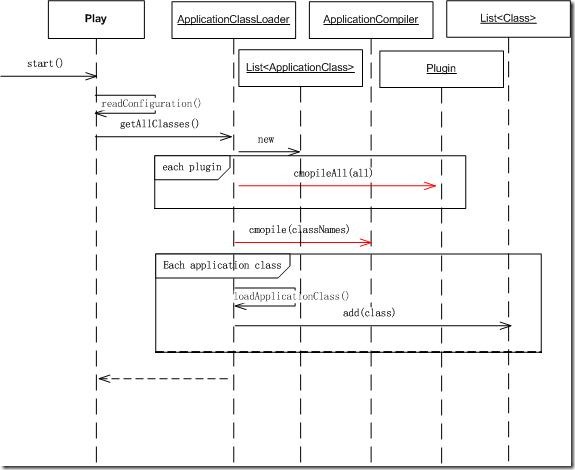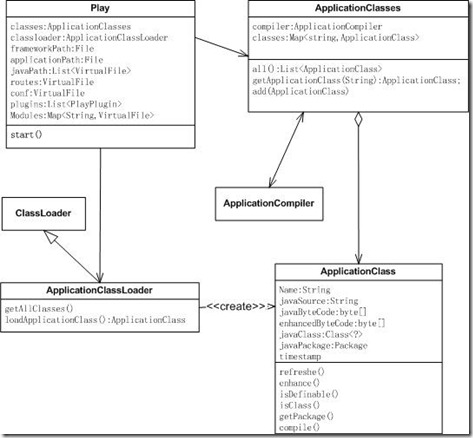这期内容当中小编将会给大家带来有关如何用Play源代码分析Server启动过程,文章内容丰富且以专业的角度为大家分析和叙述,阅读完这篇文章希望大家可以有所收获。
Play是个Rails风格的Java Web框架。
如何调试请看此处。以下进入正题^_^
Server启动过程主要涉及三个地方:
play.Play类:代表Play本身业务模型。
play.server.Server类:负责服务器启动。
play.classloading包:负责.java文件读取、编译和加载。
总体流程:

Server.main为入口方法:
public static void main(String[] args) throws Exception { … Play.init(root, System.getProperty("play.id", "")); if (System.getProperty("precompile") == null) { new Server(); } else { Logger.info("Done."); } }做两件事:
Play.init
然后创建Server对象。
Play.init
public static void init(File root, String id) { … readConfiguration(); Play.classes = new ApplicationClasses(); … // Build basic java source path VirtualFile appRoot = VirtualFile.open(applicationPath); roots.add(appRoot); javaPath = new ArrayList<VirtualFile>(2); javaPath.add(appRoot.child("app")); javaPath.add(appRoot.child("conf")); // Build basic templates path templatesPath = new ArrayList<VirtualFile>(2); templatesPath.add(appRoot.child("app/views")); // Main route file routes = appRoot.child("conf/routes"); … // Load modules loadModules(); … // Enable a first classloader classloader = new ApplicationClassloader(); // Plugins loadPlugins(); // Done ! if (mode == Mode.PROD ||preCompile() ) { start(); } … }主要做:
加载配置
new ApplicationClasses();加载app、views和conf路径到VirtualFile中,VirtualFile是Play内部的统一文件访问接口,方便后续读取文件
加载route
加载Module,Play的应用扩展组件。
加载Plugin,Play框架自身的扩展组件。
工作在产品模式则启动Play.
关键步骤为new ApplicationClasses(),执行computeCodeHashe(),后者触发目录扫描,搜索.java文件。相关过程简化代码如下:
public ApplicationClassloader() { super(ApplicationClassloader.class.getClassLoader()); // Clean the existing classes for (ApplicationClass applicationClass : Play.classes.all()) { applicationClass.uncompile(); } pathHash = computePathHash(); … }int computePathHash() { StringBuffer buf = new StringBuffer(); for (VirtualFile virtualFile : Play.javaPath) { scan(buf, virtualFile); } return buf.toString().hashCode(); }void scan(StringBuffer buf, VirtualFile current) { if (!current.isDirectory()) { if (current.getName().endsWith(".java")) { Matcher matcher = Pattern.compile("\\s+class\\s([a-zA-Z0-9_]+)\\s+").matcher(current.contentAsString()); buf.append(current.getName()); buf.append("("); while (matcher.find()) { buf.append(matcher.group(1)); buf.append(","); } buf.append(")"); } } else if (!current.getName().startsWith(".")) { for (VirtualFile virtualFile : current.list()) { scan(buf, virtualFile); } } }Start流程

简化代码如下:
public static synchronized void start() { try { ... // Reload configuration readConfiguration(); ... // Try to load all classes Play.classloader.getAllClasses(); // Routes Router.detectChanges(ctxPath); // Cache Cache.init(); // Plugins for (PlayPlugin plugin : plugins) { try { plugin.onApplicationStart(); } catch(Exception e) { if(Play.mode.isProd()) { Logger.error(e, "Can't start in PROD mode with errors"); } if(e instanceof RuntimeException) { throw (RuntimeException)e; } throw new UnexpectedException(e); } } ... // Plugins for (PlayPlugin plugin : plugins) { plugin.afterApplicationStart(); } } catch (PlayException e) { started = false; throw e; } catch (Exception e) { started = false; throw new UnexpectedException(e); } }关键步骤为执行Play.classloader.getAllClasses()加载app目录中的类型。简化代码如下:
public List<Class> getAllClasses() { if (allClasses == null) { allClasses = new ArrayList<Class>(); if (Play.usePrecompiled) { ... } else { List<ApplicationClass> all = new ArrayList<ApplicationClass>(); // Let's plugins play for (PlayPlugin plugin : Play.plugins) { plugin.compileAll(all); } for (VirtualFile virtualFile : Play.javaPath) { all.addAll(getAllClasses(virtualFile)); } List<String> classNames = new ArrayList<String>(); for (int i = 0; i < all.size(); i++) { if (all.get(i) != null && !all.get(i).compiled) { classNames.add(all.get(i).name); } } Play.classes.compiler.compile(classNames.toArray(new String[classNames.size()])); for (ApplicationClass applicationClass : Play.classes.all()) { Class clazz = loadApplicationClass(applicationClass.name); if (clazz != null) { allClasses.add(clazz); } } ... } } return allClasses; }主要步骤:
plugin.compileAll,给所有plugin一次机会进行自定义编译。
Play.classes.compiler.compile(classNames.toArray(new String[classNames.size()]));编译所有.java文件。编译后的.class存储在ApplicationClass中。内部使用了eclipse的JDT编译器。
loadApplicationClass,取出ApplicationClass中的.class加入List<Class>中返回。
到此完成.java的加载。相关对象关系如下图:

接着new Server()启动HTTP服务,监听请求
简化代码如下:
public Server() { ... if (httpPort == -1 && httpsPort == -1) { httpPort = 9000; } ... InetAddress address = null; try { if (p.getProperty("http.address") != null) { address = InetAddress.getByName(p.getProperty("http.address")); } else if (System.getProperties().containsKey("http.address")) { address = InetAddress.getByName(System.getProperty("http.address")); } } catch (Exception e) { Logger.error(e, "Could not understand http.address"); System.exit(-1); } ServerBootstrap bootstrap = new ServerBootstrap(new NioServerSocketChannelFactory( Executors.newCachedThreadPool(), Executors.newCachedThreadPool()) ); try { if (httpPort != -1) { bootstrap.setPipelineFactory(new HttpServerPipelineFactory()); bootstrap.bind(new InetSocketAddress(address, httpPort)); bootstrap.setOption("child.tcpNoDelay", true); if (Play.mode == Mode.DEV) { if (address == null) { Logger.info("Listening for HTTP on port %s (Waiting a first request to start) ...", httpPort); } else { Logger.info("Listening for HTTP at %2$s:%1$s (Waiting a first request to start) ...", httpPort, address); } } else { if (address == null) { Logger.info("Listening for HTTP on port %s ...", httpPort); } else { Logger.info("Listening for HTTP at %2$s:%1$s ...", httpPort, address); } } } } catch (ChannelException e) { Logger.error("Could not bind on port " + httpPort, e); System.exit(-1); } ... }主要步骤:
设置端口,地址
new ServerBootstrap,创建jboss netty服务器。Play1.1.1使用了netty作为底层通讯服务器。
new HttpServerPipelineFactory(),设置netty所需的请求处理管道工厂。它负责当请求到达时提供处理者。
bootstrap.bind(new InetSocketAddress(address, httpPort),绑定地址,端口。
上述就是小编为大家分享的如何用Play源代码分析Server启动过程了,如果刚好有类似的疑惑,不妨参照上述分析进行理解。如果想知道更多相关知识,欢迎关注亿速云行业资讯频道。
亿速云「云数据库 MySQL」免部署即开即用,比自行安装部署数据库高出1倍以上的性能,双节点冗余防止单节点故障,数据自动定期备份随时恢复。点击查看>>
免责声明:本站发布的内容(图片、视频和文字)以原创、转载和分享为主,文章观点不代表本网站立场,如果涉及侵权请联系站长邮箱:is@yisu.com进行举报,并提供相关证据,一经查实,将立刻删除涉嫌侵权内容。